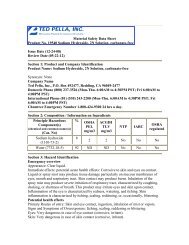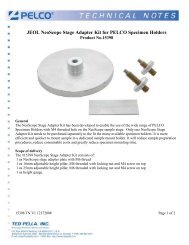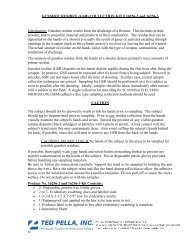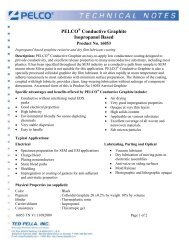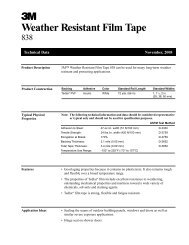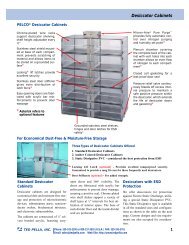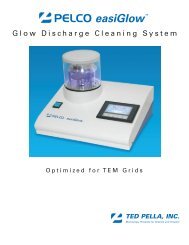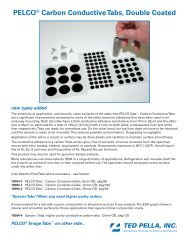Alconox MSDS.pdf - Ted Pella, Inc.
Alconox MSDS.pdf - Ted Pella, Inc.
Alconox MSDS.pdf - Ted Pella, Inc.
You also want an ePaper? Increase the reach of your titles
YUMPU automatically turns print PDFs into web optimized ePapers that Google loves.
MATERIAL SAFETY DATA SHEETRisk Phrases:R20: Harmful by inhalationR36/37/38: Irritating to eyes, respiratory system and skinSafety Phrases:S8: Keep container dryS22: Do not breath dustS24/25: Avoid contact with skin and eyesALCONOX®HEALTH HAZARDS OR RISKS FROM EXPOSURE:ACUTE: Exposure to this product may cause irritation of the eyes, respiratory system and skin. Ingestion may cause gastrointestinalirritation including pain, vomiting or diarrhea.CHRONIC: This product contains an ingredient which may be corrosive.TARGET ORGANS: ACUTE: Eye, respiratory System, Skin CHRONIC: None KnownSECTION 3 - COMPOSITION and INFORMATION ON INGREDIENTSHAZARDOUS INGREDIENTS: CAS # EINECS # ICSC # WT %Sodium Bicarbonate 144-55-8 205-633-8 1044 33 - 43%Sodium (C10 – C16)Alkylbenzene Sulfonate68081-81-2 268-356-1 Not Listed 10 – 20%Sodium Tripolyphosphate 7758-29-4 231-838-7 1469 5 - 15%Tetrasodium Pyrophosphate 7722-88-5 231-767-1 1140 5 - 15%Sodium Carbonate 497-19-8 207-638-8 1135 1 - 10%Sodium Alcohol Sulfate 151-21-3 205-788-1 0502 1 – 5%Balance of other ingredients are non-hazardous or less than 1% in concentration (or 0.1% forcarcinogens, reproductive toxins, or respiratory sensitizers).NOTE:HAZARD CLASSIFICATION;RISK PHRASESHAZARD CLASSIFICATION: NoneRISK PHRASES: NoneHAZARD CLASSIFICATION: NoneRISK PHRASES: NoneHAZARD CLASSIFICATION: NoneRISK PHRASES: NoneHAZARD CLASSIFICATION: NoneRISK PHRASES: NoneHAZARD CLASSIFICATION: [Xi] IrritantRISK PHRASES: R36HAZARD CLASSIFICATION: NoneRISK PHRASES: NoneALL WHMIS required information is included in appropriate sections based on the ANSI Z400.1-2004 format. This product has been classified inaccordance with the hazard criteria of the CPR and the <strong>MSDS</strong> contains all the information required by the CPR, EU Directives and theJapanese Industrial Standard JIS Z 7250: 2000.SECTION 4 - FIRST-AID MEASURESContaminated individuals of chemical exposure must be taken for medical attention if any adverse effect occurs. Rescuers should betaken for medical attention, if necessary. Take copy of label and <strong>MSDS</strong> to health professional with contaminated individual.EYE CONTACT: If product enters the eyes, open eyes while under gentle running water for at least 15 minutes. Seekmedical attention if irritation persists.SKIN CONTACT: Wash skin thoroughly after handling. Seek medical attention if irritation develops and persists. Removecontaminated clothing. Launder before re-use.INHALATION: If breathing becomes difficult, remove victim to fresh air. If necessary, use artificial respiration to supportvital functions. Seek medical attention if breathing dificulty continues.INGESTION: If product is swallowed, call physician or poison control center for most current information. If professionaladvice is not available, do not induce vomiting. Never induce vomiting or give diluents (milk or water) to someone whois unconscious, having convulsions, or who cannot swallow. Seek medical advice. Take a copy of the label and/or<strong>MSDS</strong> with the victim to the health professional.MEDICAL CONDITIONS AGGRAVATED BY EXPOSURE: Pre-existing skin, or eye problems may be aggravated byprolonged contact.RECOMMENDATIONS TO PHYSICIANS: Treat symptoms and reduce over-exposure.May 2011 Page 2 of 7 Rev 1



